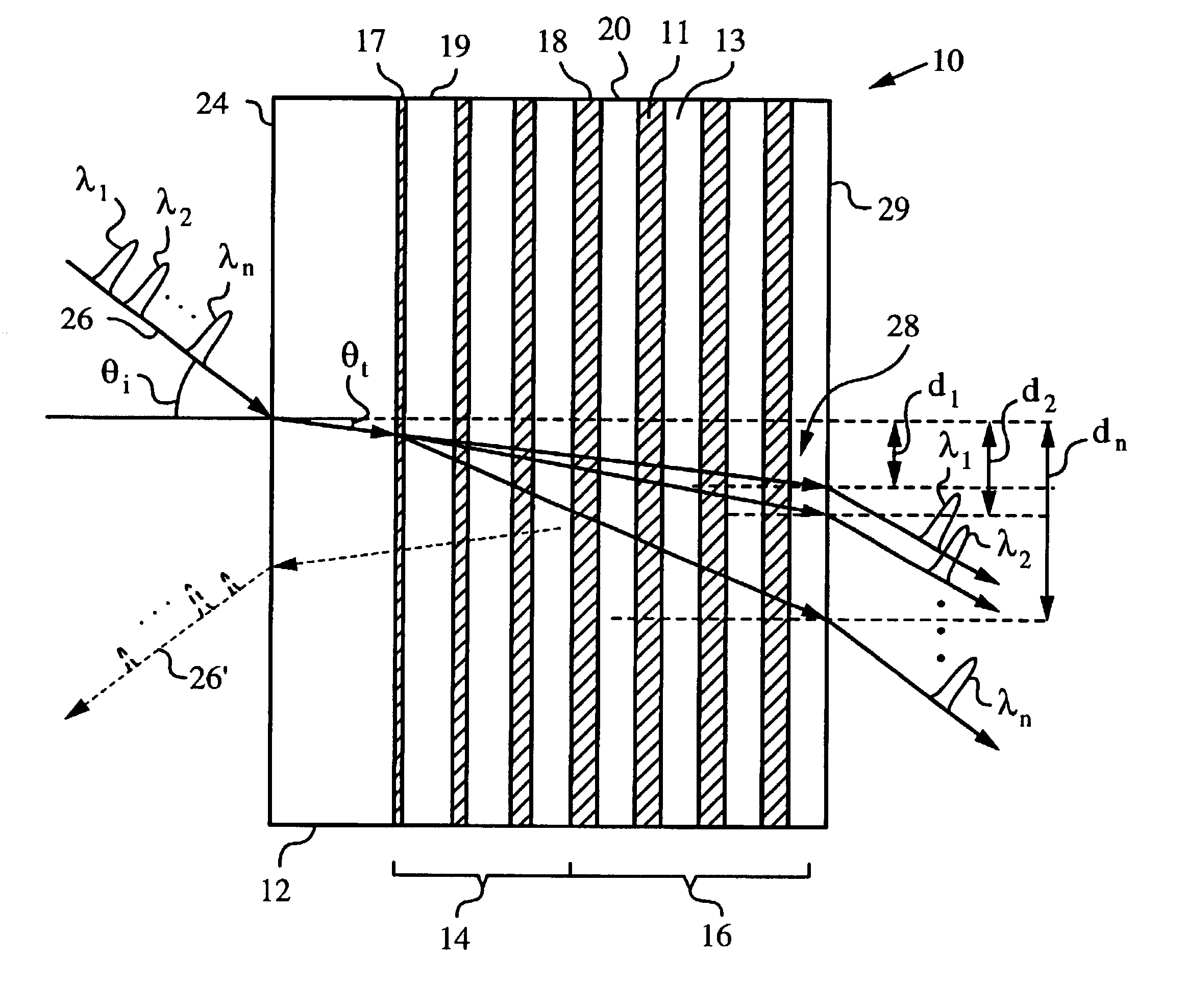Apparatus and method employing multilayer thin-film stacks for spatially shifting light
- Summary
- Abstract
- Description
- Claims
- Application Information
AI Technical Summary
Benefits of technology
Problems solved by technology
Method used
Image
Examples
example 1
[0071]FIG. 5 illustrates the thicknesses of layers in an apparatus according to the invention. The apparatus has a structure of stacks including 60 silicon dioxide / tantalum pentoxide layers using a wavelength dependent turning point. Portions of the stacks are double-chirped to yield impedance matching and spatial shifting at the same time. The chirped Bragg wavelength λB in units of meters as a function of the period number m is given by: λB(m)=1.414*10-61-8.47*10-3*m.
[0072]Periods 1 to 25 of the stack are double-chirped and the layer thicknesses of the high index layers dHDC and low index layers dLDC are calculated as a function of the period number m, the vacuum angle of incidence θi and the high and low refractive indices nH and nL by: dHDC(m)=λB(25)4nH1-(sin(θi)nH)2(m25)1.05,anddLDC(m)=λB(m)2-dHDC(m)nH1-(sin(θi)nH)24nL1-(sin(θi)nL)2.
The last 5 periods are single-chirped with the layer thicknesses of the high index layers dHSC and low index layers dLSC calculated...
example 2
[0074]FIG. 7 illustrates the thicknesses of layers in another apparatus according to the invention. The apparatus has a structure of stacks including 33 layers with four energy confinement regions. It should be noted that using energy confinement regions is preferable when the light to be separated into light components contains a narrow range of wavelengths, e.g. 10 nm or 20 nm. The layers are made of silicon dioxide and tantalum pentoxide. In this example the total thickness is 28.4 μm, the angle of incidence θi of the light is 54° and the light is s-polarized. The shift of light components as a function of wavelength between 1530 nm and 1560 nm is illustrated in FIG. 8A. FIG. 8B illustrates the reflectivity of the structure over the same range of wavelengths.
example 3
[0075]FIG. 9 illustrates the thicknesses of layers in yet another apparatus according to the invention. The apparatus has a structure of stacks including 66 layers using a combination of the turning point, energy confinement and superprism effects. The layers are made of silicon dioxide and tantalum pentoxide. The total thickness is 23.9 μm, the angle of incidence θi of the light is 45° and the light is p-polarized. The graphs in FIGS. 10A and 10B illustrate the shift of light components as a function of wavelength and reflectivity of the structure over a wavelength range from 1515 to 1570 nm.
PUM
 Login to View More
Login to View More Abstract
Description
Claims
Application Information
 Login to View More
Login to View More - R&D
- Intellectual Property
- Life Sciences
- Materials
- Tech Scout
- Unparalleled Data Quality
- Higher Quality Content
- 60% Fewer Hallucinations
Browse by: Latest US Patents, China's latest patents, Technical Efficacy Thesaurus, Application Domain, Technology Topic, Popular Technical Reports.
© 2025 PatSnap. All rights reserved.Legal|Privacy policy|Modern Slavery Act Transparency Statement|Sitemap|About US| Contact US: help@patsnap.com



